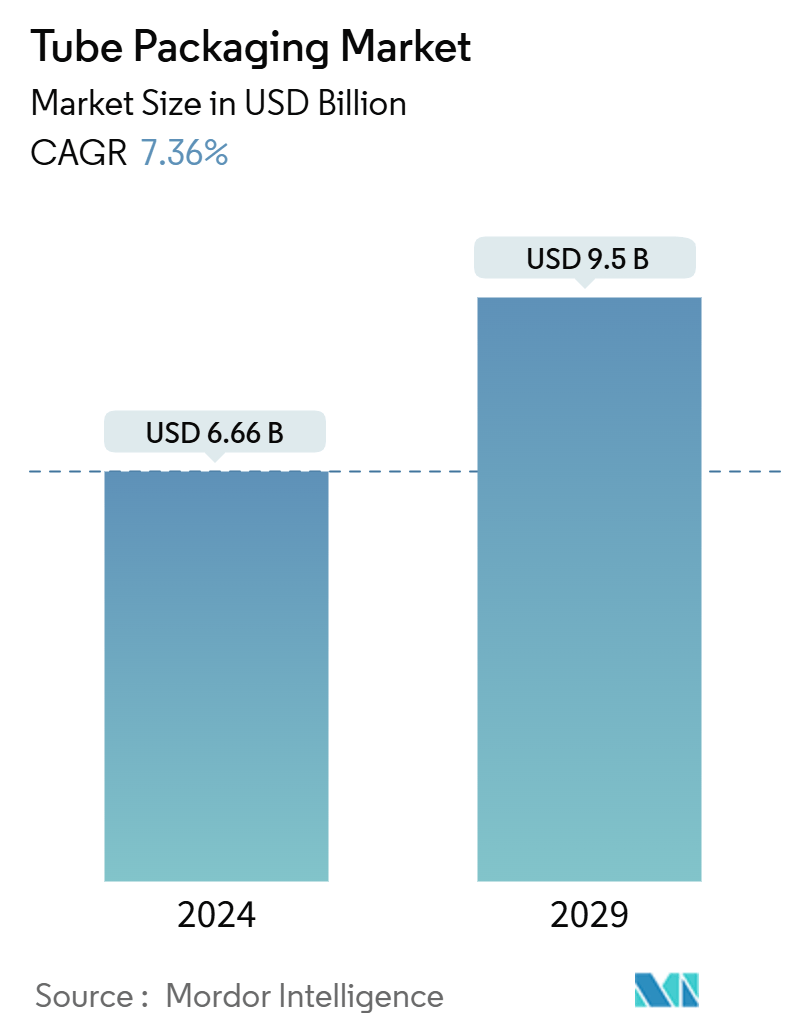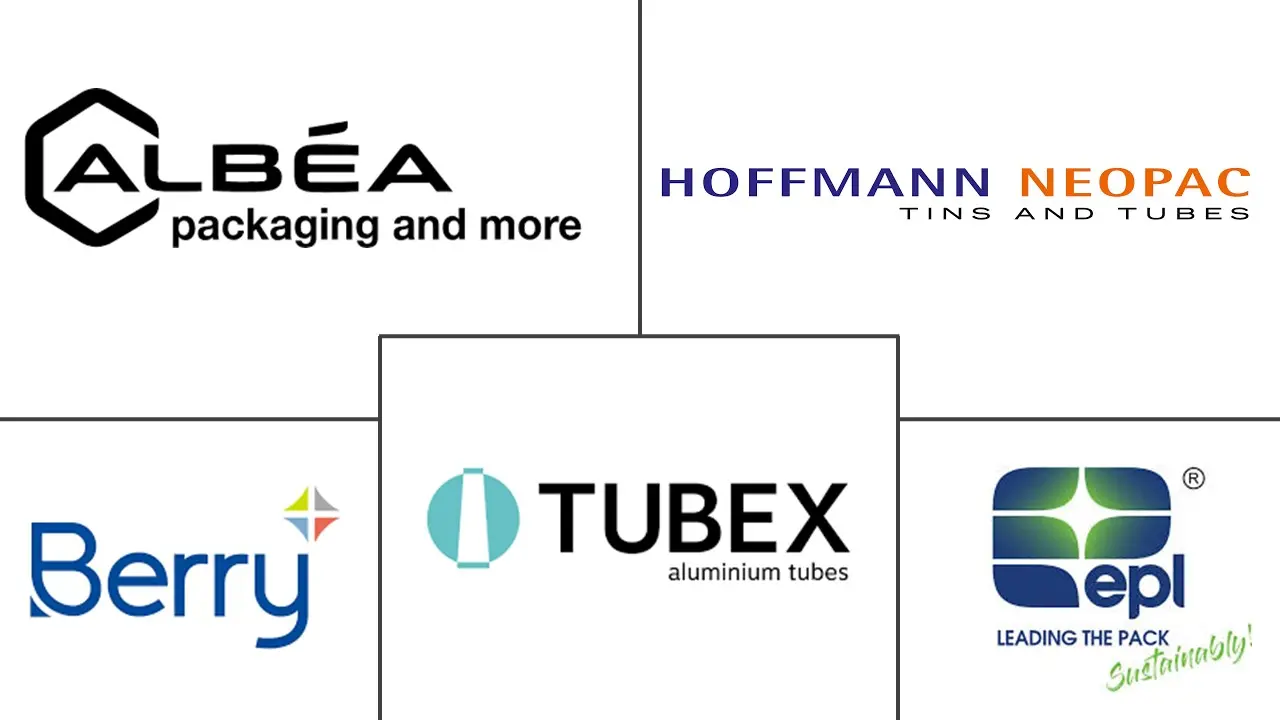Market Size of Tube Packaging Industry

| Study Period | 2019 - 2029 |
| Market Size (2024) | USD 6.66 Billion |
| Market Size (2029) | USD 9.5 Billion |
| CAGR (2024 - 2029) | 7.36 % |
| Fastest Growing Market | Asia Pacific |
| Largest Market | Asia Pacific |
| Market Concentration | Low |
Major Players
*Disclaimer: Major Players sorted in no particular order |
Tube Packaging Market Analysis
The Tube Packaging Market size is estimated at USD 6.66 billion in 2024, and is expected to reach USD 9.5 billion by 2029, at a CAGR of 7.36% during the forecast period (2024-2029).
- Tubes have become a prevalent packaging choice in the cosmetics and personal care sector, due to their user-friendly design, portability, and versatility in storing and dispensing products. The tube packaging market is on an upward trajectory, fueled by urbanization, a burgeoning millennial demographic, and rising disposable incomes. As urban areas evolve, there is heightened awareness and accessibility to cosmetic products. Coupled with increased disposable income, this urban development presents lucrative opportunities for market players, significantly amplifying the demand for tube packaging.
- Laminated tubes, with their advanced multi-layered barrier structure, currently dominate the market. Their superior barrier properties not only extend product shelf-life but also shield against oxygen, light, and bacteria, driving their heightened demand.
- The global tube packaging sector is witnessing a surge in demand, particularly from the oral care segment. As public awareness of oral hygiene's significance rises, so do dental care costs. These heightened concerns, alongside evolving lifestyles, are propelling the tube packaging market's global growth and spurring demand for specialized oral care products.
- Furthermore, the cosmetic packaging sector is undergoing a technological renaissance, with a pronounced focus on elevating user experience. Innovations like integrated brushes, sponge heads, pump-equipped tubes, and other novel applicators are fueling this demand.
- However, the tube packaging market grapples with stringent regulations. While these regulations prioritize product safety and environmental sustainability, they also influence manufacturing processes, material choices, and the market's overall growth trajectory. Adhering to these regulations often necessitates hefty investments in research and development, which can escalate production costs for tube packaging producers.
Tube Packaging Industry Segmentation
Tube packaging refers to a type of packaging that uses a cylindrical or tube-like container to hold and protect products. This form of packaging is commonly used for products like cosmetics, personal care items, pharmaceuticals, and food. Tubes are often made from materials such as plastic, aluminum, or paper, and they can feature various closures, such as screw caps, flip-top lids, or nozzle dispensers. The market has been tracked from the consumption aspect, which packaging companies integrate with clients for revenue. This report analyzes the factors such as the impact of raw materials, drivers, and challenges on the studied market based on the prevalent base scenarios, key themes, and application-related demand cycles.
The tube packaging market is segmented by type of package (squeeze, twist, and other type of package), material (plastic, paperboard, and aluminum), application (cosmetics & toiletries, healthcare & pharmaceutical, food, homecare, and other application), and geography (North America (United States and Canada), Europe (United Kingdom, Germany, France, Italy, and Rest of Europe), Asia Pacific (China, Japan, India, and Rest of Asia Pacific), Latin America (Brazil, Argentina, Mexico, and Rest of Latin America), and Middle East and Africa (United Arab Emirates, Saudi Arabia, and Rest of Middle East and Africa)). The report offers market forecasts and size in value (USD) for all the above segments.
| By Type of Package | |
| Squeeze | |
| Twist | |
| Other Type of Package |
| By Material | |
| Plastic | |
| Paperboard | |
| Aluminum |
| By Application | |
| Cosmetics & Toiletries | |
| Healthcare & Pharmaceutical | |
| Food | |
| Homecare | |
| Other Application |
| Geography*** | ||||||
| ||||||
| ||||||
| ||||||
| Australia and New Zealand | ||||||
| ||||||
|
Tube Packaging Market Size Summary
The tube packaging market is experiencing significant growth, driven by its popularity in the cosmetic and personal care sectors due to its convenience and flexibility. Urbanization, a growing millennial population, and increasing disposable incomes are key factors propelling market expansion. Laminated tubes, known for their excellent barrier properties, are dominating the market by enhancing product shelf life and protection. The pharmaceutical industry, particularly in dermatology, is also a major contributor to market growth, with tube packaging being extensively used for medicines. Technological advancements in packaging, such as innovative applicators, are further boosting demand. However, regional regulations pose challenges to market growth.
Plastic remains the dominant material in tube packaging due to its cost-effectiveness, durability, and flexibility. The demand for plastic tubes is rising, especially in the cosmetic industry, as convenience and hygiene become more important. Despite environmental concerns, the industry is shifting towards sustainable packaging solutions, with a focus on recyclable and compostable materials, influenced by regulatory targets in the EU and the American Chemical Council. The Asia-Pacific region is witnessing increased demand due to improved living standards and a rise in cosmetic and pharmaceutical products. The market is highly fragmented, with numerous players and a high likelihood of new entrants, leading to intense competition and a focus on innovation and strategic partnerships. Key players include Amcor, Bemis, and Tetrapack, with recent developments highlighting strategic acquisitions and collaborations to enhance supply chain sustainability.
Tube Packaging Market Size - Table of Contents
-
1. MARKET INSIGHTS
-
1.1 Market Overview
-
1.2 Industry Attractiveness - Porter's Five Forces Analysis
-
1.2.1 Threat of New Entrants
-
1.2.2 Bargaining Power of Buyers
-
1.2.3 Bargaining Power of Suppliers
-
1.2.4 Threat of Substitute Products
-
1.2.5 Intensity of Competitive Rivalry
-
-
1.3 Industry Ecosystem Analysis
-
1.4 Industry Standards & Regulations
-
1.5 Technology Outlook
-
1.6 Import-Export Analysis
-
1.7 Raw Material Analysis
-
-
2. MARKET SEGMENTATION
-
2.1 By Type of Package
-
2.1.1 Squeeze
-
2.1.2 Twist
-
2.1.3 Other Type of Package
-
-
2.2 By Material
-
2.2.1 Plastic
-
2.2.2 Paperboard
-
2.2.3 Aluminum
-
-
2.3 By Application
-
2.3.1 Cosmetics & Toiletries
-
2.3.2 Healthcare & Pharmaceutical
-
2.3.3 Food
-
2.3.4 Homecare
-
2.3.5 Other Application
-
-
2.4 Geography***
-
2.4.1 North America
-
2.4.1.1 United States
-
2.4.1.2 Canada
-
-
2.4.2 Europe
-
2.4.2.1 United Kingdom
-
2.4.2.2 Germany
-
2.4.2.3 France
-
2.4.2.4 Italy
-
-
2.4.3 Asia
-
2.4.3.1 China
-
2.4.3.2 Japan
-
2.4.3.3 India
-
-
2.4.4 Australia and New Zealand
-
2.4.5 Latin America
-
2.4.5.1 Brazil
-
2.4.5.2 Argentina
-
2.4.5.3 Mexico
-
-
2.4.6 Middle East and Africa
-
2.4.6.1 United Arab Emirates
-
2.4.6.2 Saudi Arabia
-
-
-
Tube Packaging Market Size FAQs
How big is the Tube Packaging Market?
The Tube Packaging Market size is expected to reach USD 6.66 billion in 2024 and grow at a CAGR of 7.36% to reach USD 9.5 billion by 2029.
What is the current Tube Packaging Market size?
In 2024, the Tube Packaging Market size is expected to reach USD 6.66 billion.

